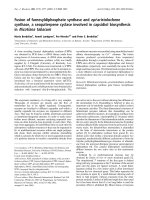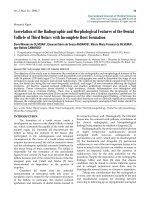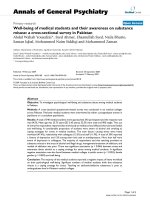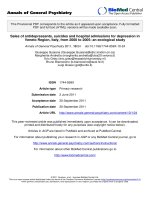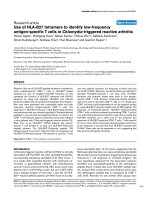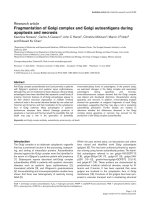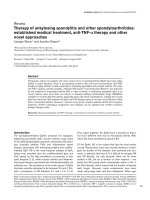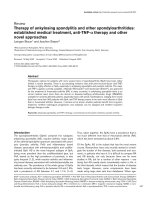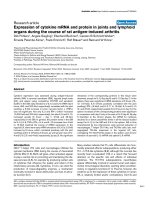Báo cáo y học: "Well-being of medical students and their awareness on substance misuse: a cross-sectional survey in Pakistan" ppt
Bạn đang xem bản rút gọn của tài liệu. Xem và tải ngay bản đầy đủ của tài liệu tại đây (183.28 KB, 5 trang )
BioMed Central
Page 1 of 5
(page number not for citation purposes)
Annals of General Psychiatry
Open Access
Primary research
Well-being of medical students and their awareness on substance
misuse: a cross-sectional survey in Pakistan
Abdul Wahab Yousafzai*, Syed Ahmer, Ehsanullah Syed, Naila Bhutto,
Saman Iqbal, Mohammed Naim Siddiqi and Mohammed Zaman
Address: Department of Psychiatry, Aga Khan University, Karachi 74800, Pakistan
Email: Abdul Wahab Yousafzai* - ; Syed Ahmer - ; Ehsanullah Syed - ;
Naila Bhutto - ; Saman Iqbal - ; Mohammed Naim Siddiqi - ;
Mohammed Zaman -
* Corresponding author
Abstract
Objective: To investigate psychological well-being and substance abuse among medical students
in Pakistan.
Methods: A cross-sectional questionnaire-based survey was conducted in six medical colleges
across Pakistan. Final-year medical students were interviewed by either a postgraduate trainee in
psychiatry or a consultant psychiatrist.
Results: A total of 540 medical students were approached; 342 participated and the response rate
was 64.5%. Mean age was 23.73 years (SD 2.45 years); 52.5% were male and 90% single. Two out
of every five respondents reported that work/study at medical school affected their personal health
and well-being. A considerable proportion of students were aware of alcohol and smoking as
coping strategies for stress in medical students. The main factors causing stress were heavy
workload (47.4%), relationship with colleagues (13.5%) and staff (11.9%). A total of 30% reported
a history of depression and 15% among them had used an antidepressant. More than half were
aware of depression in colleagues. The majority of respondents said that teaching provided on
substance misuse in the areas of alcohol and illegal drugs, management/treatment of addiction, and
models of addiction was poor. There was significant association (p = 0.044) between stress and
awareness about alcohol as a coping strategy for stress among medical students. A significant
negative association was also found between medical colleges in public sector (p = 0.052), female
gender (p = 0.003) and well-being.
Conclusion: The majority of the medical students reported a negative impact of heavy workload
on their psychological well-being. Significant numbers of medical students think that substance
misuse is a coping strategy for stress. Teaching on addiction/addictive substances is poor at
undergraduate level in Pakistani medical colleges.
Published: 19 February 2009
Annals of General Psychiatry 2009, 8:8 doi:10.1186/1744-859X-8-8
Received: 30 September 2008
Accepted: 19 February 2009
This article is available from: />© 2009 Yousafzai et al; licensee BioMed Central Ltd.
This is an Open Access article distributed under the terms of the Creative Commons Attribution License ( />),
which permits unrestricted use, distribution, and reproduction in any medium, provided the original work is properly cited.
Annals of General Psychiatry 2009, 8:8 />Page 2 of 5
(page number not for citation purposes)
Introduction
Medicine has been a gratifying profession and held in
high esteem since dawn of the history. It not only requires
commitment, enthusiasm and altruism, but physicians
are also expected to show care, compassion and a dedica-
tion to their profession.
Few studies have looked at stress related to medical edu-
cation. Studies conducted in medical schools in the US
and UK show a negative impact on student's physical and
mental health [1-3]. A review of the literature by Liselotte
et al. [4] showed the likely causes would be adjustments
to the environment, ethical and moral dilemmas, expo-
sure to human suffering, abuse, personal life events and
debt. With passing years, the research highlights worsen-
ing distress and this can lead to impairment in academic
performance, mental health problems and burnout.
A study from Newcastle, UK, showed that college students
as a whole have a higher prevalence of alcohol drinking
and alcohol use disorders than non-college youth [5].
Medical students therefore are a high-risk population. As
high as 20% of first-year medical students admit to exces-
sive alcohol intake, attributing it to stress, anxiety, and
examination and work pressures [6]. A survey of eight US
medical schools revealed 20% of students to have engaged
in binge-drinking at least once in the past 30 days and
28% of students reported an increase in alcohol consump-
tion during medical school [7].
Studies from Pakistan [8-10] have focused on perception
of substance misuse, coping strategies and suicidal idea-
tion among medical students. Our study looks at the well-
being of medical students and their awareness on sub-
stance misuse, capturing data from six medical colleges
across all the provinces of Pakistan.
Materials and methods
Final-year medical students were approached in six medi-
cal colleges of four provinces in Pakistan to participate in
the study. These include two from North-West Frontier
Province (NWFP), two in Sind Province and one each in
Baluchistan and Punjab.
In total 343 students participated in the survey.
We used a questionnaire which has already been used by
British Medical Association (BMA) in survey of medical
student's well-being in UK [11].
The questionnaire was in the English language, which is
the medium of instruction in all medical colleges in Paki-
stan. The questionnaire consisted of seven items with
multiple responses, covering psychological well-being of
the students, their awareness about substance misuse, and
depression. We collapsed some of the responses for the
purpose of simplicity.
A demographic extraction sheet containing age, gender,
marital status and background (whether rural or urban)
was used to record the demographic variables. The data
was collected by either a postgraduate trainee in psychia-
try or consultant psychiatrist, and the anonymity of the
respondent was insured. The study was approved by
departmental ethical committee.
Data was entered in SPSS version 16.0 (SPSS, Chicago, IL,
USA) and the frequencies of responses calculated. We also
used the chi square test to assess the significance between
different variables.
Results
Out of a total of 540 medical students from the 6 medical
colleges, 342 participated in the survey, yielding response
rate of 64.5%. The mean age of respondents was 23.73
years (standard deviation (SD) 2.45 years), 52.5% were
male and 90% were single.
With regard to ethnic distribution, 19.9% were Punjabis,
29.5% Pukhtuns, 11.5% Urdu speaking, 22.5% Sindis,
and 7.6% Balochi. The number of students from rural and
urban backgrounds was almost equal. The overwhelming
majority (91%) were Muslims.
Tables 1 and 2 show the frequencies of responses. Three
out of five respondents reported that work/study at medi-
cal school affected their personal health and well-being.
Whilst 58.2% and 74.9% reported that they were not
Table 1: Frequency of responses to stress-related questions
Responses
Questions Yes, n (%) No, n (%) Missing, n (%)
Has your health been affected by stress? 234 (68.6) 96.1 (28.1) 11 (3.2)
Does work at medical school affect your personal health and well-being? 59 (17.3) 274 (82.7) 0
Are you aware of use of smoking in medical students to cope with stress? 134 (39.2) 199 (58.2) 7 (2.0)
Are you aware of use of alcohol in medical students to cope with stress? 78 (22.8) 256 (74.9) 6 (1.8)
Annals of General Psychiatry 2009, 8:8 />Page 3 of 5
(page number not for citation purposes)
aware of smoking and alcohol use as a coping strategy for
stress among medical students.
Heavy workload (47.4%), followed by relationship with
colleagues (13.5%) and staff (11.9%) appeared to be the
main sources of stress as shown in figure 1.
While 30% of respondents reported that they have suf-
fered from depression, only 15% have used antidepres-
sant medications. More than half were aware of their
colleagues suffering from depression and were using anti-
depressant medication.
The majority of the respondents were of the opinion
teaching provided on substance misuse in the areas of
alcohol, illegal drugs, management/treatment of addic-
tion, and models of addiction is poor as shown in table 3.
The association between demographic variables and well-
being is shown in Table 4. Government medical colleges
(p value = 0.072), and female gender (p value = 0.003)
had a significant association with stress. Alcohol use as
coping strategy was found to be significantly associated
with stress among medical students (p value = 0.044), as
shown in Table 5.
Discussion
This study is part of a larger project covering well-being
and bullying of medical students in Pakistan. Other find-
ings will be reported separately.
The training period for medical students is a constantly
changing environment of 5 to 6 years, to ensure that grad-
uates gain sufficient skills. Some aspects of the training
have been found to have negative effects on the student's
life, which manifest in the form of stress, depression and
burn out.
An important finding of this survey is the prevalence of
stress among medical students; about 65% of them found
the training period stressful. This finding is in agreement
with other studies conducted in Pakistan [8] and else-
where [4].
An alarming result of this study is the awareness of a sig-
nificant number (39.2%) of students about smoking and
alcohol (22.8%) as coping mechanisms for stress in their
colleagues. This finding lends support to previous
research from Pakistan, showing that 90% of medical stu-
dents perceived academic stress as being responsible for
drug use among medical students [8]. Drug use among
medical students is a worldwide phenomenon; for exam-
ple, a survey of an American medical school showed alco-
hol, benzodiazepine and opiate use to be higher than age-
matched controls [12]. Moreover, alcohol and drug addic-
tion represents 80% to 90% of all physician impairment
cases in the US, and is a source of major concern for health
authorities [13].
With regard to the main factors responsible for causing
stress, the majority of the students attribute it to heavy
workload (47.4%) followed by relationship with col-
leagues (13.5%) and staff (11.9%). This finding is consist-
ent with a BMA survey in the UK [11]. Similarly, workload
such as academic studies and exams have been found to
be major sources of stress among Pakistani medical stu-
dents [10] though such workload varies for medical stu-
dents on a yearly basis and is, usually, coupled with
concerns for academic performance [4].
Table 2: Frequency of responses to questions related to depression
Questions Responses
Yes, myself, n (%) Yes, my colleagues, n (%) Not aware, n (%) Missing, n (%)
Are you aware of depression amongst medical
students?
103 (30.1) 178 (52.0) 52 (15.2) 9 (2.6)
Are you aware of use of antidepressants amongst
medical students?
54 (15.8) 180 (52.6) 97 (28.4) 11 (3.2)
Factors causing stress among medical studentsFigure 1
Factors causing stress among medical students.
4%
4%
11%
13%
6%
4%
9%
1%
48%
MissingOtherRelationship with staff
Relationship with colleagueDomestic responsibilityFamily
FinancialHeavy workloadNil
Annals of General Psychiatry 2009, 8:8 />Page 4 of 5
(page number not for citation purposes)
Almost 40% (40.1%) of participants reported a history of
depression, while more than 50% were aware of depres-
sion among their fellow students. This is the most striking
finding of our study. Similar findings have been reported
in other research from Pakistan; for example, one study
reported suicidal ideation in a third of Pakistani medical
students [9]. In part this could be a reflection of a high
prevalence of common mental disorders in Pakistan [14].
Various studies from US have identified a high frequency
of depression and suicidal tendencies among medical stu-
dents; in fact, suicide ranks second among the leading
causes of death in medical students [15]. In a UK survey,
about 14% of medical students reported depression while
53% were found aware of depression amongst their col-
leagues.
The medical students in this survey reported poor teach-
ing on substance abuse. This could be explained by the
fact that psychiatry is not taught as a major subject at
undergraduate level in Pakistan except in a few medical
colleges. As such it is understandable that students will be
less likely to know a great deal about substance abuse
problems.
Female medical students and government-run institutions
have been found to be negatively associated with health
and well-being of medical students. This finding is con-
sistent with studies conducted previously in Pakistan [10]
and elsewhere [16]. Regarding government institutes, gen-
erally less institutional support is available to the students
in Pakistan. Another reason could be the fact that less
affluent students only gain admission into public institu-
tions, which could make them more vulnerable to stress.
A significant association between stress and awareness of
alcohol use as a coping strategy for stress is an important
finding of this study. This finding necessitates the need for
further research to study actual alcohol use in stressed
medical students.
Limitations
This is a preliminary study concerning medical students
and substance use, with obvious limitations. Direct fig-
ures were not obtained on actual patterns of substance
misuse among medical students, and associations were
observed. Additionally, no attempts were made to inter-
view students for current depressive symptoms. For psy-
chological well-being, self-report was used instead of
standard scale measurements.
Our sample may also not be representative of the popula-
tion; for example, only one medical college was selected
from Punjab, which is the largest province of Pakistan.
Table 3: Feedback on teaching received on substance misuse
Substances Responses
Excellent, n (%) Adequate, n (%) Poor, n (%)
Alcohol 67 (19.6) 106 (31.0) 163 (47.7)
Illegal drugs 48 (14.0) 98 (28.7) 190 (55.5)
Prescribed drugs 59 (17.3) 136 (39.8) 141 (41.0)
Over the counter drugs 30 (8.8) 103 (30.1) 203 (59.4)
Models of addiction 33 (9.6) 97 (28.4) 206 (60.2)
Management/treatment of addiction 29 (29) 94 (27.5) 213 (63.4)
Substance abuse by students/professionals 35 (10.2) 110 (32.2) 191 (55.8)
Prevention of substance abuse 36 (10.5) 93 (27.7) 207 (60.5)
Missing, 6 each (1.8).
Table 4: Demographic characteristics and association with well-being
Variables Does work at medical school affect your personal health and well-being? p Value
Yes No
Type of college: 0.052
Private 43 10
Government 165 75
Gender: 0.003
Male 99 54
Female 113 28
Values statistically significant at the level of p < 0.05.
Publish with BioMed Central and every
scientist can read your work free of charge
"BioMed Central will be the most significant development for
disseminating the results of biomedical research in our lifetime."
Sir Paul Nurse, Cancer Research UK
Your research papers will be:
available free of charge to the entire biomedical community
peer reviewed and published immediately upon acceptance
cited in PubMed and archived on PubMed Central
yours — you keep the copyright
Submit your manuscript here:
/>BioMedcentral
Annals of General Psychiatry 2009, 8:8 />Page 5 of 5
(page number not for citation purposes)
Conclusion
High levels of distress have been reported by medical stu-
dents in Pakistan, and a significant proportion reported
that their well-being has been affected by stress. The vast
majority of medical students reported that they know of
colleagues who use alcohol and smoking to cope with
stress. Moreover, workload was cited by the majority of
students as the source of stress.
Depression among medical students is high, as reported
by the students in this survey. There is general agreement
amongst medical students that the teaching of substance
abuse in medical schools is over all poor.
Competing interests
The authors declare that they have no competing interests.
Authors' contributions
AWY Conceived the idea and also took part in collection
and analysis of data and wrote the initial draft of the arti-
cle. SA took part in data analysis and manuscript writing.
ES: did literature search and reviewed the manuscript
while NB collected the data and retrieved the relevant ref-
erences. SI: Analyze the data, and reviewed the manu-
script. MNS: Reviewed the manuscript. MZ: entered and
analyzed the data.
References
1. Moffat KJ, Mc Connachie A, Ross S, Morrison JM: First year medi-
cal student stress and coping in a problem-based learning
medical curriculum. Med Educ 2004, 38:482-491.
2. Givens JL, Tjia J: Depressed medical students' use of mental
health services and barriers to use. Acad Med 2002, 77:918-921.
3. Ball S, Bax A: Self-care in medical education: effectiveness of
health habits interventions for first-year medical students.
Acad Med 2002, 77:911-917.
4. Dyrbye LN, Thomas MR, Shanafelt TD: Medical student distress:
causes, consequences, and proposed solutions. Mayo Clin Proc
2005, 80:1613-1622.
5. Firth-Cozens J: Interventions to improve physicians' well-being
and patient care. Soc Sci Med 2001, 52:215-222.
6. Gutgesell M, Reeve R, Parsons B, Morse R: Exercise and alcohol
consumption among medical students. Acad Med 1999,
74:750-751.
7. Mangus R, Hawkins C, Miller M: Tobacco and alcohol use among
1996 medical school graduates. JAMA 1998, 280:1192-1193.
8. Shafiq M, Shah Z, Saleem A, Siddiqi MT, Shaikh KS, Salahuddin FF,
Siwani R, Naqvi H: Perceptions of Pakistani medical students
about drugs and alcohol: a questionnaire-based survey. Subst
Abuse Treat Prev Policy 2006, 1:11-18.
9. Kokar S, Khan MM: Suicidal ideation in Pakistani medical stu-
dents. Crisis 2005, 26:125-127.
10. Sheikh BT, Arsalan Kahloon A, Kazmi M, Khalid H, Nawaz K, A Khan
N, Khan S: Students, stress, and coping strategies: a case of
Pakistani medical school. Educ Health 2004, 17:346-353.
11. British Medical Association: Medical students welfare survey
report 2006. [ />welfare2005].
12. Baldwin DC, Hughes PH, Conard SE, Storr CL, Sheehan DV: Sub-
stance use among senior medical students: a survey of 23
medical schools. JAMA 1991, 265:2074-2078.
13. Aresteiguieta CA: Substance abuse, mental illness, and medical
students: the role of Americans with Disabilities act. JAMA
1998, 279:80.
14. Mirza I, Jenkins R: Risk factors, prevalence, and treatment of
anxiety and depressive disorders in Pakistan: a systematic
review. BMJ 2004, 328:794.
15. Hays LR, Cheever T, Patel P: Medical students suicide, 1989–
1994. Am J Psychiatry 1996, 153:553-555.
16. Amr M, Gilany AH, El-Hawary A: Does gender predict medical
students' stress in Mansoura, Egypt? Med Educ Online 2008,
13:12.
Table 5: Demographics and alcohol use in association with stress
Variables Has your health ever been affected by stress? p Value
Yes No
Type of college: 0.164
Private 48 6
Government 195 46
Gender: 0.626
Male 130 27
Female 118 21
Awareness of alcohol use to cope with stress: 0.044
Yes 70 8
No 201 51
Values statistically significant at the level of p < 0.05.

